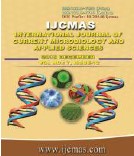


 National Academy of Agricultural Sciences (NAAS)
National Academy of Agricultural Sciences (NAAS)

|
PRINT ISSN : 2319-7692
Online ISSN : 2319-7706 Issues : 12 per year Publisher : Excellent Publishers Email : editorijcmas@gmail.com / submit@ijcmas.com Editor-in-chief: Dr.M.Prakash Index Copernicus ICV 2018: 95.39 NAAS RATING 2020: 5.38 |
Silica nanoparticles were synthesized efficiently and effectively from rice husk and characterized by various analytical techniques. The highest percentage (89.28 ± 0.03 %) yield of silica synthesized from rice husk ash burnt at 700 ºC for 2 h. Dynamic light scattering analysis data of silica nanoparticles (SNPs) showed that the average particles diameter 93.14 nm with hydrophilic nature. The UV-Visible spectrum Si-O-Si bond confirming the presence of silica nanoparticles the presence of silica nanoparticles. FT-IR data revealed the presence of hydrogen bonded silanol and siloxane groups in SNPs, XRD pattern revealed amorphous form. SEM analysis data showed that uniformly distributed silica nanoparticles were in the agglomerated form with spherical shape. The use of rice husk as source of SNPs has both positive environmental and economic impact through the use of an abundant low-value agricultural by-product that can alleviate waste disposal problems.
 |
 |
 |
 |
 |